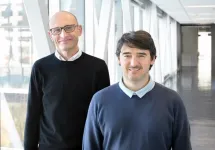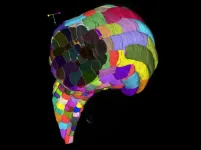(Press-News.org) Peer reviewed/ Simulation/modelling /People
A new AI model can flag female patients who are at higher risk of heart disease based on an electrocardiogram (ECG).
The researchers say the algorithm, designed specifically for female patients, could enable doctors to identify high-risk women earlier, enabling better treatment and care. Details are published today in Lancet Digital Health.
An ECG records the electrical activity of the heart and is one of the most common medical tests in the world. In their study, funded by the British Heart Foundation, the researchers used artificial intelligence to analyse over one million ECGs from 180,000 patients, of whom 98,000 were female.
In the latest study, the researchers developed a score that measures how closely an individual's ECG matches ‘typical’ patterns of ECGs for men and women, and which showed a range of risk for each sex. Women whose ECGs more closely matched the typical ‘male’ pattern – such as having an increased size of the electrical signal – tended to have larger heart chambers and more muscle mass.
Crucially, these women were also found to have a significantly higher risk of cardiovascular disease, future heart failure, and heart attacks, compared to women with ECGs more closely matching the ‘typical female’ ECG.
Previous evidence has shown that men tend to be at higher risk of heart disease - more accurately called cardiovascular disease - which may be due to differences in hormone profiles and lifestyle factors. Because of this, healthcare professionals and the public believe that women’s risk of cardiovascular disease is low. This is even though the risk for women is also high, with women twice as likely to die of coronary heart disease, the main cause of heart attack, than from breast cancer in the UK. A recent consensus statement called cardiovascular disease the “number one killer” of women. The statement called for better diagnosis and treatment for women, as well as better female representation in clinical trials.
Dr Arunashis Sau, Academic Clinical Lecturer at Imperial College London’s National Heart and Lung Institute, and cardiology registrar at Imperial College Healthcare NHS Trust, led the research. He said:
"Our work has underlined that cardiovascular disease in females is far more complex than previously thought. In the clinic we use tests like ECGs to provide a snapshot of what’s going on but as a result this may involve grouping patients by sex in a way that doesn’t take into account their individual physiology. The AI enhanced ECGs give us a more nuanced understanding of female heart health – and we believe this could be used to improve outcomes for women at risk of heart disease.”
Dr Fu Siong Ng, Reader in Cardiac Electrophysiology at the National Heart & Lung Institute at Imperial College London and a consultant cardiologist at Imperial College Healthcare NHS Trust and Chelsea and Westminster Hospital NHS Foundation Trust, was the senior author of the study. He said: “Many of the women identified were in fact at even higher risk than the ‘average’ man. If it becomes used widely, over time the AI model may reduce gender differences in cardiac care, and improve outcomes for women at risk of heart disease.”
The research group recently published another paper on the related AI-ECG risk estimation model, known as AIRE, which can predict patients’ risk of developing and worsening disease from an ECG. Trials of AIRE in the NHS are already planned for late 2025. These will evaluate the benefits of implementing the model with real patients from hospitals across Imperial College Healthcare NHS Trust and Chelsea and Westminster Hospital NHS Foundation Trust. This model will be trialled in conjunction with AIRE.
Dr Sonya Babu-Narayan, Clinical Director at the British Heart Foundation, said: “Far too often, women are misdiagnosed or even dismissed by healthcare professionals, thanks to the myth that heart disease is 'only a male’ issue. Even if they do receive the right diagnosis, evidence shows that women are less likely than men to receive recommended treatments.”
“This study has applied powerful AI technology to ECGs, a routine, cheap and widely available heart test. Harnessing the potential of this type of research could help better identify those patients at highest risk of future heart problems and reduce the gender gap in heart care outcomes. However, one test alone will not level the playing field. Ensuring every person gets the right heart care they need when they need it will require change in every part of our healthcare system.”
The research was funded by the British Heart Foundation, via a BHF Clinical Research Training Fellowship to Dr Sau, a BHF Programme Grant to Dr Fu Siong Ng, and the BHF Centre of Research Excellence at Imperial. The researchers also received support from the NIHR Imperial Biomedical Research Centre, a translational research partnership between Imperial College Healthcare NHS Trust and Imperial College London, which was awarded £95m in 2022 to continue developing new experimental treatments and diagnostics for patients.
Artificial intelligence-enhanced electrocardiography for the identification of a sex-related cardiovascular risk continuum: a retrospective cohort study is published in Lancet Digital Health
For more information, please contact:
Samantha Rey
Media Officer (Medicine)
Imperial College London
Tel: +44 (0)20 7594 1507
E-mail: s.rey@imperial.ac.uk
Medicine.media@imperial.ac.uk
Out of hours duty media officer: +44(0) 7803 886 248
This press release uses a labelling system developed by the Academy of Medical Sciences to improve the communication of evidence. For more information, please see: http://www.sciencemediacentre.org/wp-content/uploads/2018/01/AMS-press-release-labelling-system-GUIDANCE.pdf
Notes for Editors:
About Imperial College London:
We are Imperial – a world-leading university for science, technology, engineering, medicine and business (STEMB), where scientific imagination leads to world-changing impact.
As a global top ten university in London, we use science to try to understand more of the universe and improve the lives of more people in it. Across our nine campuses and throughout our Imperial Global network, our 22,000 students, 8,000 staff, and partners work together on scientific discovery, innovation and entrepreneurship. Their work navigates some of the world’s toughest challenges in global health, climate change, AI, business leadership and more.
Founded in 1907, Imperial’s future builds on a distinguished past, having pioneered penicillin, holography and fibre optics. Today, Imperial combines exceptional teaching, world-class facilities and a habit of interdisciplinary practice to unlock scientific imagination.
About Imperial College Healthcare NHS Trust
Imperial College Healthcare is one of the largest NHS Trusts in England, with over 15,000 staff providing acute and specialist healthcare to over one million people a year.
The Trust runs five hospitals in central and west London - Charing Cross, Hammersmith, Queen Charlotte's and Chelsea, St Mary's and the Western Eye.
The Trust also hosts the National Institute for Health and Care Research Imperial Biomedical Research Centre, in partnership with Imperial College London.
Find out more: www.imperial.nhs.uk
About the British Heart Foundation
It is only with donations from the public that the BHF can keep its life saving research going. Help us turn science fiction into reality. With donations from the public, the BHF funds ground-breaking research that will get us closer than ever to a world free from the fear of heart and circulatory diseases. A world where broken hearts are mended, where millions more people survive a heart attack, where the number of people dying from or disabled by a stroke is slashed in half. A world where people affected by heart and circulatory diseases get the support they need. And a world of cures and treatments we can’t even imagine today. Find out more at bhf.org.uk
About the data in this research:
The system was developed using a dataset of over 1 million ECGs from about 190,000 patients and then validated in the United Kingdom. Cohorts used in this study:
The Beth Israel Deaconess Medical Center (BIDMC) cohort is a secondary care dataset comprised of routinely collected data from Boston, USA.
UK Biobank is the world’s most comprehensive source of biomedical data available for health research in the public interest. END
AI model can read ECGs to identify female patients at higher risk of heart disease
2025-02-26
ELSE PRESS RELEASES FROM THIS DATE:
Biological organ ages predict disease risk decades in advance
2025-02-26
Our organs age at different rates, and a blood test determining how much they’ve each aged could predict the risk of conditions like lung cancer and heart disease decades later, finds a new study led by University College London (UCL) researchers.
The findings, published in The Lancet Digital Health, show how accelerated ageing in specific organs can predict not only diseases affecting that organ, but diseases across the rest of the body as well.
Lead author Professor Mika Kivimaki (UCL Faculty of Brain Sciences) said: “Our organs function as an integrated system, but they can age at different rates. ...
New manzanita species discovered, already at risk
2025-02-25
A new species of manzanita — a native California shrub famous for its twisted branches and wildfire resilience — has been discovered on the central coast, but its survival is already threatened by urban development that could destroy much of its fragile population.
The discovery is detailed in a new study published in PhytoKeys, where researchers used genetic analysis to confirm the plant as a distinct species. Named Arctostaphylos nipumu to honor the Nipomo Mesa where it was discovered and its indigenous heritage, the species stands out for its shaggy gray bark — ...
Giant ice bulldozers: How ancient glaciers helped life evolve
2025-02-25
New Curtin University research has revealed how massive ancient glaciers acted like giant bulldozers, reshaping Earth’s surface and paving the way for complex life to flourish.
By chemically analysing crystals in ancient rocks, the researchers discovered that as glaciers carved through the landscape, they scraped deep into the Earth’s crust, releasing key minerals that altered ocean chemistry.
This process had a profound impact on our planet’s composition, creating conditions that allowed ...
Toward high electro-optic performance in III-V semiconductors
2025-02-25
(Santa Barbara, Calif.) — From integrated photonics to quantum information science, the ability to control light with electric fields — a phenomenon known as the electro-optic effect — supports vital applications such as light modulation and frequency transduction. These components rely on nonlinear optical materials, in which light waves can be manipulated by applying electric fields.
Conventional nonlinear optical materials such as lithium niobate have large electro-optic response but are ...
In mouse embryos, sister cells commit suicide in unison
2025-02-25
UdeM reproductive biologist Greg FitzHarris and his team show for the first time that sister cells can communicate with each other through a bridge that allows them to die in a coordinated way.
Sister cells are a pair of cells that share the same mother cell. In a new study published in Developmental Cell, researchers led by Université de Montréal (UdeM) professor Greg FitzHarris show how the early mouse embryo gets rid of the defective or unneeded cells in pairs.
“Such a mechanism could serve to ensure the elimination of cells with a ...
Automatic cell analysis with the help of artificial intelligence
2025-02-25
Identifying and delineating cell structures in microscopy images is crucial for understanding the complex processes of life. This task is called “segmentation” and it enables a range of applications, such as analysing the reaction of cells to drug treatments, or comparing cell structures in different genotypes. It was already possible to carry out automatic segmentation of those biological structures but the dedicated methods only worked in specific conditions and adapting them to new conditions was costly. An international ...
New study highlights need for better care to prevent lung problems after abdominal surgery
2025-02-25
AURORA, Colo. (Feb. 25, 2025) – A new study, published today in The Lancet Respiratory Medicine, tested whether a set of interventions to keep lungs expanded before, during, and after abdominal surgery could lower the risk of serious breathing problems in patients compared to the usual care at 17 academic hospitals in the U.S. The research has determined that these interventions for open abdominal surgery do not result in less severe breathing problems as compared to the usual care in those hospitals.
Adult abdominal surgery patient enrollees were either given a lung expansion set of interventions or the typical care plan to follow at each hospital. ...
Microplastics in ocean linked to disabilities for coastal residents
2025-02-25
EMBARGOED FOR RELEASE UNTIL 4 P.M. ET, TUESDAY, FEBRUARY 25, 2025
Media Contacts:
Renee Tessman, rtessman@aan.com, (612) 928-6137
Natalie Conrad, nconrad@aan.com, (612) 928-6164
Microplastics in ocean linked to disabilities for coastal residents
Mobility, self-care, independent living disability higher in areas with high microplastics
MINNEAPOLIS – Tiny bits of plastic found in the ocean may be tied to a higher risk of disability for people who live in coastal areas with high levels, according to a preliminary study released today, ...
Biophysical Society announced undergraduate poster award competition winners
2025-02-25
ROCKVILLE, MD – The 10 winners of the annual Undergraduate Poster Award Competition (UPAC) were recognized at the 69th Biophysical Society Annual Meeting Awards Ceremony on February 17, 2025. After two rounds of judging, judges from every career level selected these students for their outstanding presentations during the poster competition. Seventy-four students participated in the competition.
The 2025 UPAC winners are:
Adam Gatch, Clemson University, USA – “AΒ42 Accelerates Pathogenic Structural Transformation Within ...
Successful strategies for collaborative species conservation
2025-02-25
How can the loss of species and habitats in agricultural landscapes be stopped? Up to now, measures have mostly been implemented by individual farms. In contrast, agri-environmental measures that are planned across farms at landscape level offer greater potential for creating suitable habitats for different species as a mosaic in the landscape. However, successful landscape level approaches also require cooperation between farms and other stakeholders from local governments, politics and nature conservation. Researchers at the University of Göttingen have therefore identified ...




